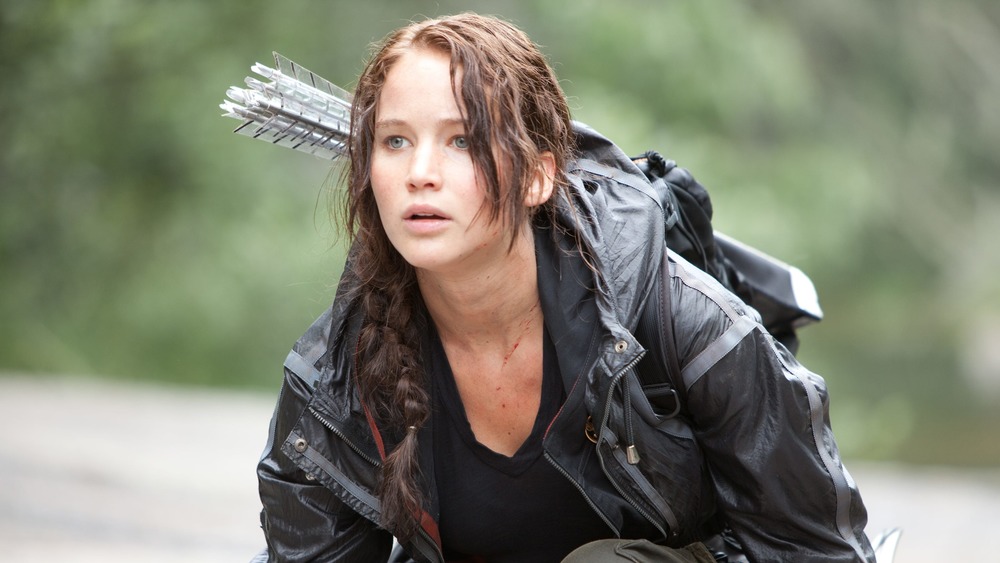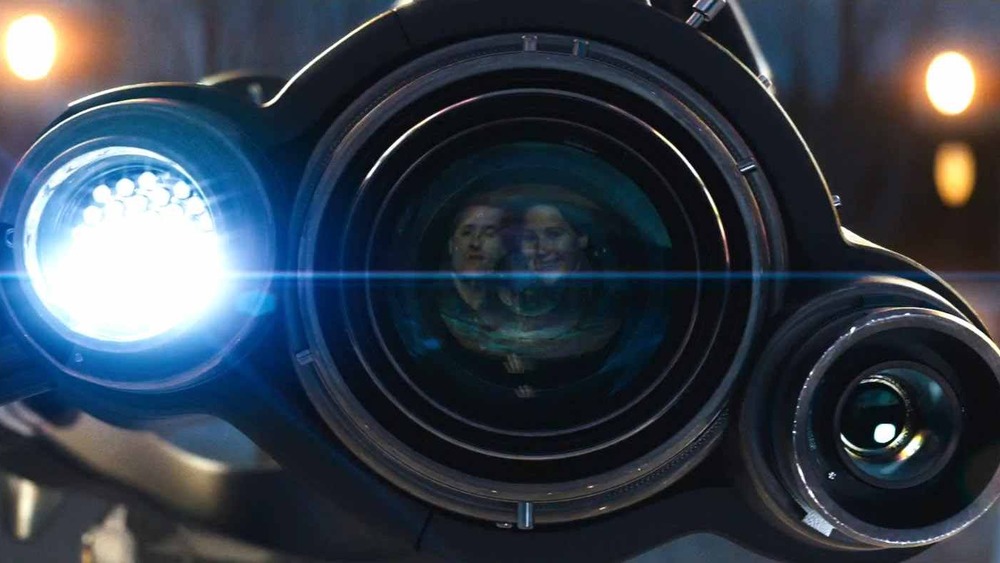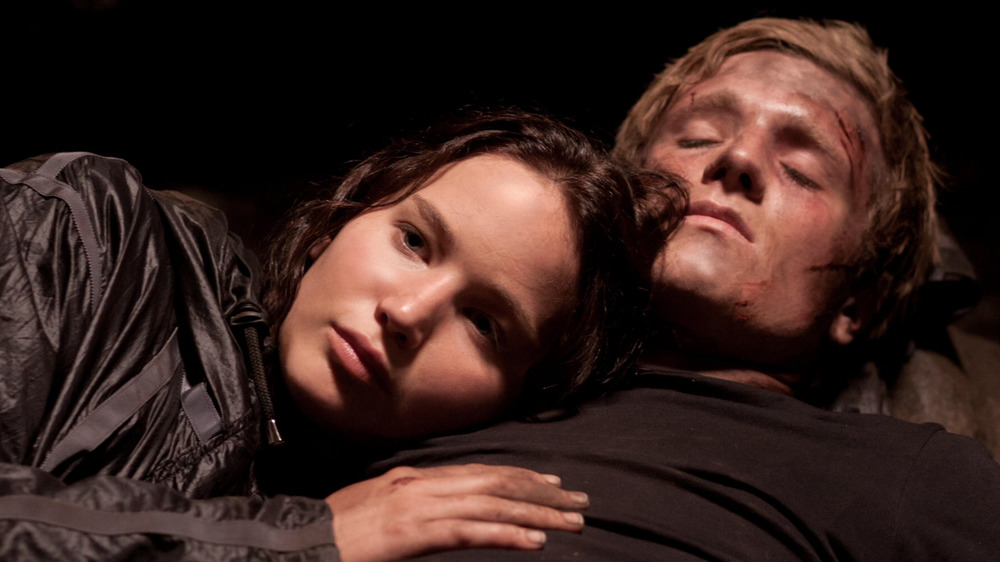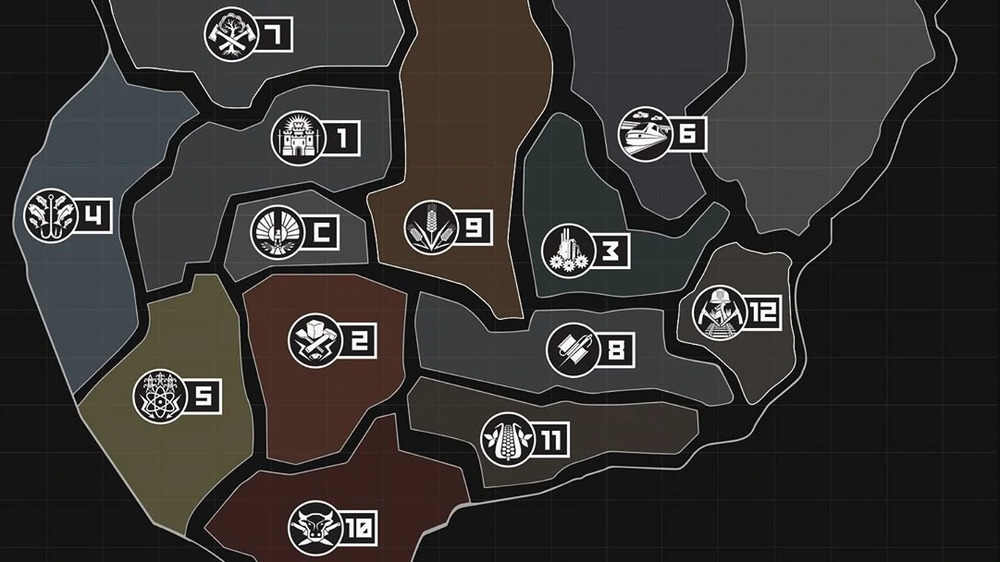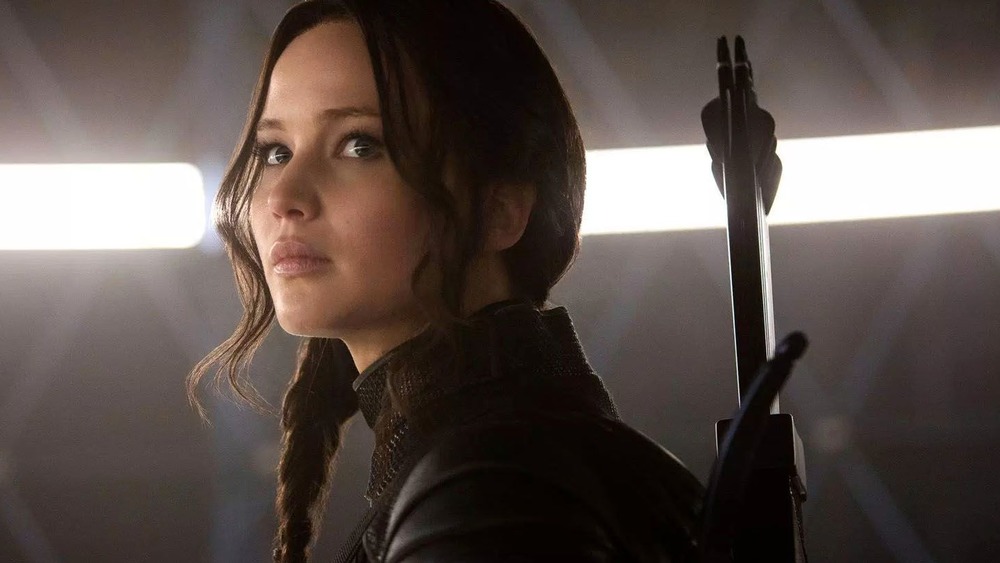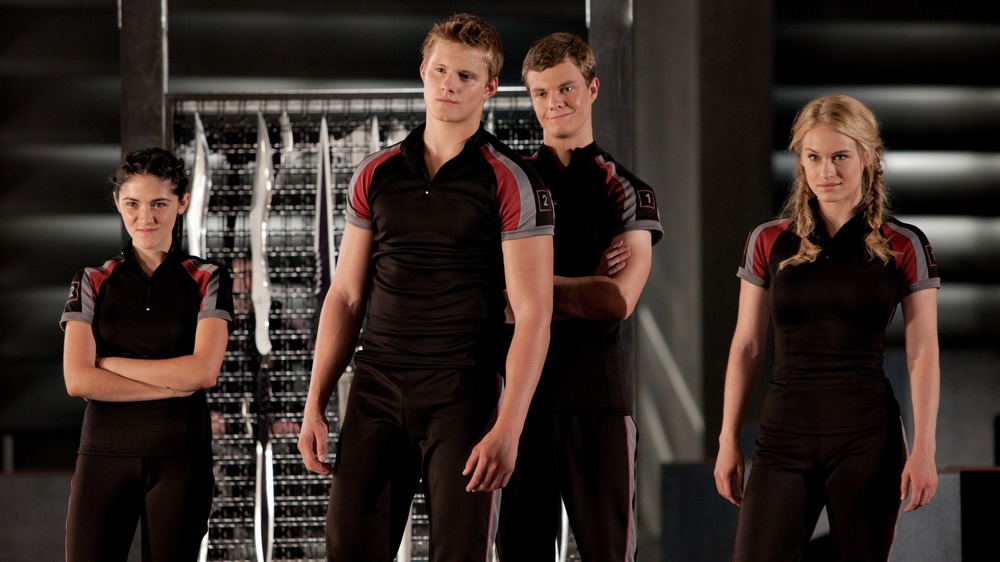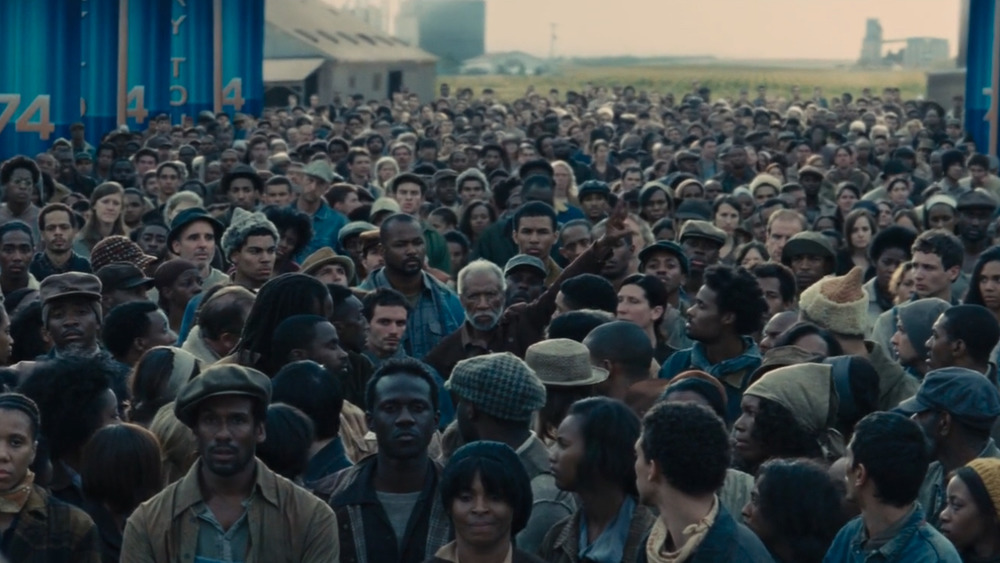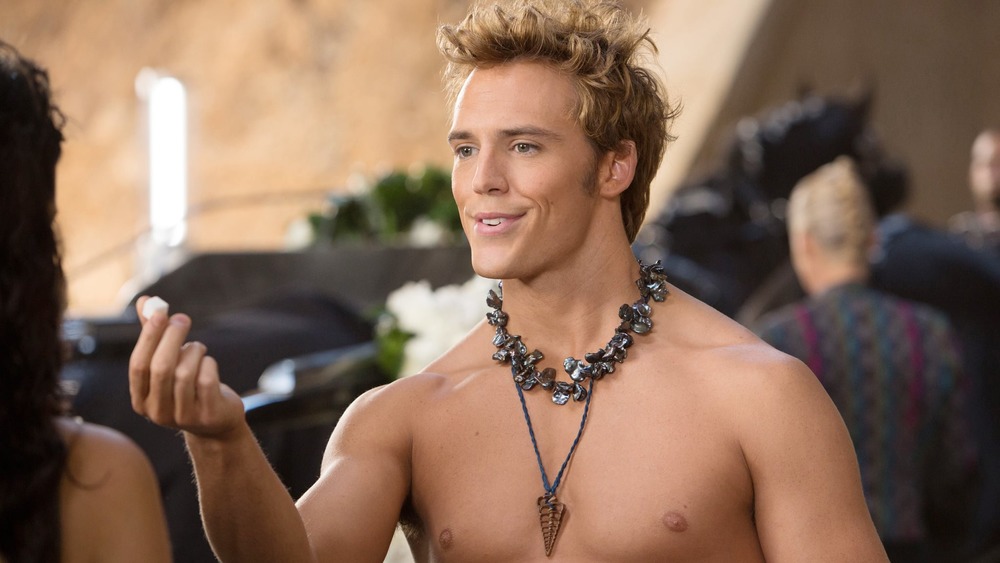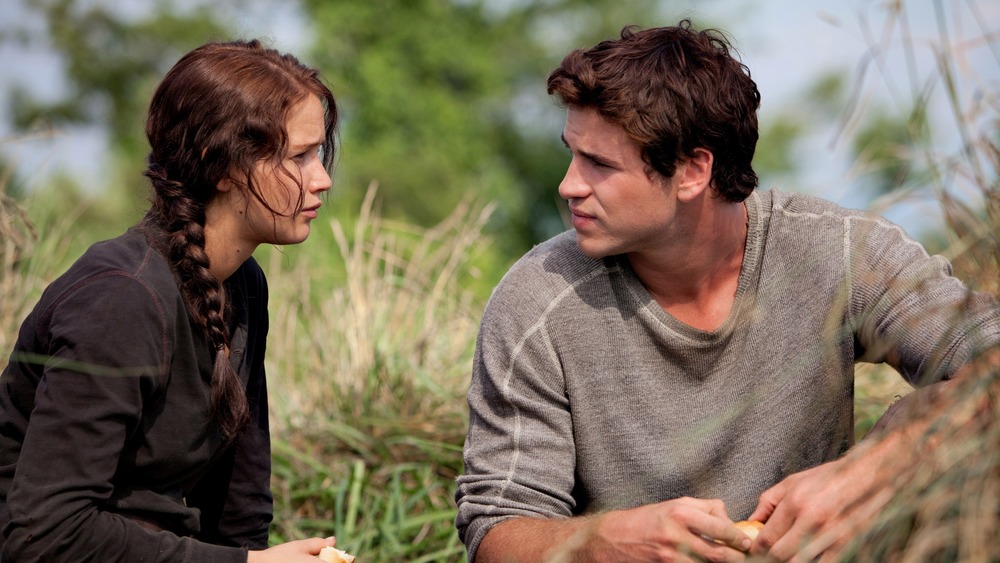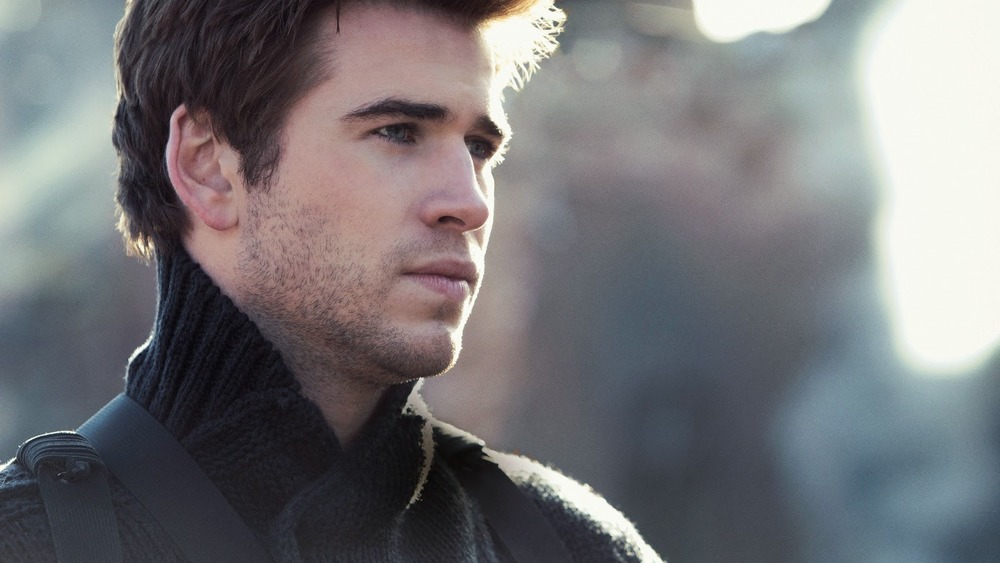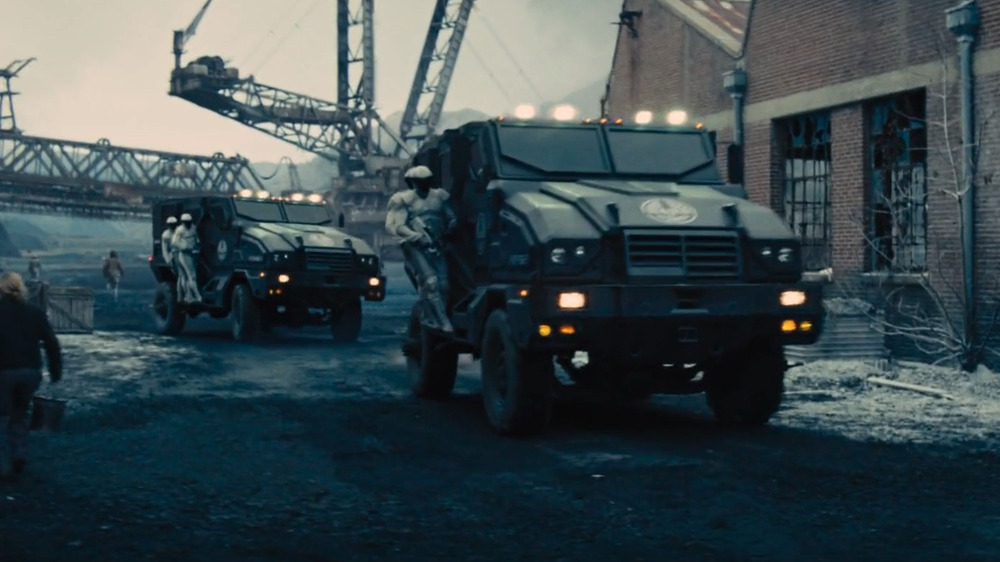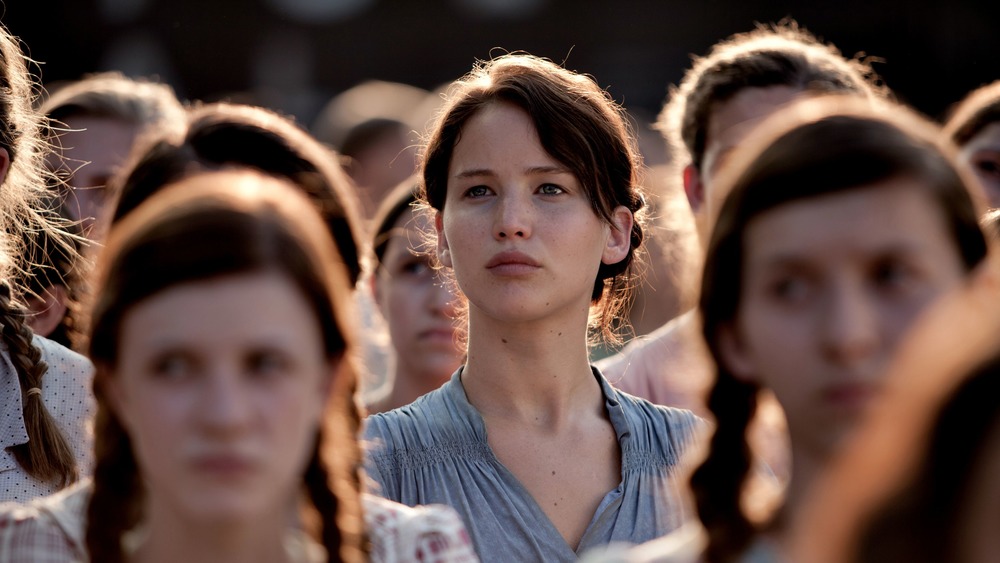Things Only Adults Notice In The Hunger Games
For many fans, The Hunger Games isn't just a young adult novel series or blockbuster movie trilogy. Many fans who were teenagers when the books and films first came out are now adults, but The Hunger Games still holds up for adult viewers and readers. Suzanne Collins, the books' author, created a lush and captivating world filled with details that younger audiences might have missed the first time around. There are also nods to the real-world inspirations that Collins drew from to create the Hunger Games universe, such as the Greek Mythology behind the games themselves or the historic framing of state-sanctioned violence that might not have clicked for viewers the first time around.
While viewers and readers might have been initially dazzled by the excesses of the Capitol or shocked when they first saw Katniss aim her bow at President Coin, certain details make a lot more sense upon further viewings as an adult. There are endless ways to analyze Suzanne Collins' source material, so here are just a few things that only adults notice in The Hunger Games.
The parallels between The Hunger Games and reality TV
Suzanne Collins, the author of The Hunger Games trilogy, has said she was initially inspired to write the series while flipping between reality TV programs and news footage of the Iraq War. This inspiration is pervasive in almost every element of Katniss' story, from the way she and Peeta heighten their supposed love for each other to attract sponsors during the Games, to the extensive machinations that happen behind the scenes to force conflicts between players.
While the premise of sending children to fight for televised sport was an obvious enough nod to reality shows for younger readers and viewers to understand, younger audiences might not catch the extent to which the games mimicked their real life counterparts.
The Gamemakers manipulate the tributes' surroundings to force conflicts, such as when Katniss is forced to flee her shelter in the 74th Games due to a forest fire and quickly finds herself in the vicinity of other tributes. What younger audiences may not realize is how much this mirrors the production of most reality TV programs, where producers may goad contestants into conflicts or might edit footage to make contestants more or less sympathetic or viewers.
Katniss and Peeta subvert traditional gender roles
Katniss is a prime example of a protagonist that defies gender roles and expectations. When audiences first meet Katniss, she's hunting to support her family — a task that typically is associated with men. Throughout their relationship, Katniss and Peeta continue to buck gender roles and display personality traits that were atypical to the young adult genre at the time.
In their first games, Katniss is seen as the most viable District 12 tribute, despite Peeta's strength. While protecting her family is her prime motivation throughout the series, Katniss is also generally depicted as cool and analytical, whereas Peeta is often driven by emotion. Their skills and hobbies also defy gender expectations: Peeta enjoys decorating cakes at the bakery and becomes a skilled painter, while Katniss excels at hunting and trapping.
They also subvert the "damsel in distress" trope throughout the series. Peeta is consistently the one who is in need of rescue, whether it's in the arena or when he's taken captive by the Capitol in Mockingjay. Conversely, Katniss is typically the one who swoops in to save him, or negotiates deals to ensure his safety.
The districts are based on real regions of the United States
While Collins does a great job of fleshing out what makes each of Panem's districts unique, what some younger readers may not realize is that each district corresponds with resources and characteristics of real regions within the United States.
For example, District 12 takes clear inspiration from Appalachia. Its main industry is coal mining, its natural features like wooded hills and green meadows are hallmarks of states like West Virginia and Kentucky, and the poverty faced by those in the Seam is not unlike that experienced by people living in Appalachia today.
Other districts also serve as loose interpretations of regions of the U.S.: District 4 is located along the Pacific coast and its residents are trained in skills like fishing and tying knots, District 7 expands across the Pacific Northwest and largely exports lumber, while District 11 produces agricultural products in the Deep South.
While each region is loosely based on real areas of the United States, the districts are largely dependent on a single industry, rather than a diverse array of trades and resources, due to climate change.
Katniss exhibits classic PTSD symptoms and coping mechanisms
It's no secret that the Hunger Games victors are traumatized from their time in the Games — they witness and take part in brutal violence in order to survive, and then are unable to talk about and process their trauma when they come home. Katniss in particular exhibits textbook symptoms of PTSD. In Catching Fire, the act of hunting acts as a trigger for Katniss, and she sees the body of a tribute when she shoots her arrow at a wild turkey. At the beginning of Mockingjay, Katniss apparently has found ways to deal with her PTSD, through coping mechanisms such as repeating facts about herself to keep herself grounded in her own reality. By focusing on the things she knows to be true, this practice helps deter intrusive thoughts about the violence she's faced.
Katniss isn't the only one who suffers from PTSD or has coping mechanisms. After Peeta is psychologically tortured by the Capitol with hallucinogenic venom, he struggles to discern between memories he experienced and those fabricated by the Capitol. Finnick suggests that he ask Katniss whether his memories are "real or not real" as an exercise that helps him regain the sense of reality he had lost.
The Careers are a metaphor for institutional privilege
All of Panem's districts are forced to participate in the annual Hunger Games, but some Districts have better chances than others. In Districts 1, 2, and 4, children are trained in special schools to be experts in combat and survival until they turn 18 and volunteer as tributes for the Hunger Games. Though training before the games is forbidden, the wealthier districts are able to sidestep these rules due to their ties and former alliance with the Capitol.
While the Capitol maintains that no one district has explicit advantages over the others, it's easy to see how the Careers are better equipped to survive the Games than tributes from poorer districts.
This inherent inequality is a lot more than just a figment of Suzanne Collins' dystopian universe – barriers to resources, education, and wealth based on one's origins exist in Panem's fictional world as well as our actual one. The Careers also symbolize how people can be given institutional privilege but still be at the mercy of a harmful system — they might have more resources to train and prepare with, but they are still doomed to be pawns in the Capitol's games.
District 11 closely mirrors American slavery
One of the most memorable characters of the first Hunger Games novel is Rue, a young tribute from District 11. Katniss describes District 11 as one of the poorer districts of Panem — its main industry is agriculture and its residents live in even worse conditions than Katniss's home in the Seam. For most older readers and viewers, it may not be hard to connect the depictions of District 11 to the United States' own complicated history with slavery.
While the books make note of how District 11 residents typically have dark skin and are forced to work under unjust conditions, the movies make the parallels between District 11 and slavery even more stark. When Peeta and Katniss first visit District 11 in Catching Fire, they see workers gathering cotton, a crop that historically relied on slave labor in the 19th century. Another parallel to slavery is that the crops that District 11's citizens gather don't benefit their own district, but the goods are instead sent to the Capitol. During the first games, Rue tells Katniss that District 11 citizens also often face harsh and violent punishments for small infractions such as stealing food or borrowing equipment after working hours.
After Peeta and Katniss give passionate speeches to District 11's citizens, they witness Panem's peacekeepers brutally assault a man who salutes Katniss in protest, a scene that's very reminiscent of racial and police violence that has persisted throughout U.S. history.
Finnick was coerced into sex work
Finnick Odair is a victor from District 4 who is forced back into the arena for Panem's 75th Hunger Games. When audiences first meet Finnick Odair in Catching Fire, he offers Katniss a sugar cube and mentions how she could have made gargantuan amounts of money in the Capitol if not for the Quarter Quell. When Katniss questions him on his wealth, he says he hasn't dealt in currency in ages, to which she responds, "How do people pay for the pleasure of your company?"
This conversation might go over the heads of younger viewers, but this exchange heavily implies that Finnick is a sex worker in the Capitol, and a highly desired one due to his victor status and handsome features. While Capitol citizens know of Finnick's proclivity for seeing multiple partners during his visits to the Capitol, they just assume he's a free-spirited flirt.
However, during the events of Mockingjay, Finnick reveals that Snow forced him to do sex work under the threat of harming his loved ones. After Haymitch's entire family was killed to make an example out of him, it's easy to understand why Finnick complied. Being forced into sex work is dark enough, but the knowledge that Finnick was only 14 when he won his first Games puts his situation in an even more tragic light.
Gale was kind of a jerk to Katniss
The Hunger Games wouldn't be a YA series without a love triangle, would it? Gale Hawthorne, Katniss' childhood best friend, vies for Katniss's affection throughout the series, and is a dramatic foil to Peeta's gentle demeanor.
In the aftermath of the 74th Hunger Games, both Peeta and Gale are hurt by Katniss pretending to be in love with Peeta in order to survive. However, Gale expresses his frustration with Katniss in Catching Fire, seeming to care more about Katniss choosing him over Peeta than he does about Katniss' complicated desires and emotions. While his pining for Katniss might seem romantic at first, his behavior is more than a bit cringeworthy when you consider it as an adult.
Gale thinks that he should be Katniss' partner over Peeta because of their shared background and deep friendship, but he never expresses his romantic interest in her prior to Katniss volunteering for the games. He also resents Katniss' affection for Peeta, even though it makes perfect sense for her to care about Peeta after their experiences together in the Capitol. While Gale's coldhearted war strategy is eventually what dooms their relationship, there are plenty of other red flags that signal how Gale is not the most supportive partner for Katniss.
Several characters struggle with addiction throughout the series
Many of the victors were traumatized by their time in the games, but didn't have proper resources to manage it when they came back home to their districts. For example, Haymitch is seen as District 12's town drunkard and is rarely seen not drinking. In Catching Fire, Katniss learns that one of the reasons he started drinking was because President Snow murdered his family for Haymitch's "rebellious" actions during the games. While not really discussed in the films, Haymitch also suffered horrendous withdrawal upon arriving at District 13. Even after the Second Rebellion, Katniss remarks that Haymitch still drinks to cope with the pain of losing his family and friends during the war.
Other previous victors also turned to substance abuse after their games. During the Quarter Quell in Catching Fire, the two tributes from District 6 are referred to as the "Morphlings" due to their drug of choice. Morphling was a powerful narcotic used throughout Panem, and takes its name from its real world counterpart, morphine. Johanna Mason also becomes dependent on the drug after she's tortured by the Capitol, even siphoning off Katniss' IV drip after her own supply is cut off.
Gale's Machiavellian take on revolution
Gale quickly rises up the ranks within District 13's rebellion for his confident leadership and his role in evacuating District 12. He also has a penchant for thinking like the enemy, even foreshadowing that keeping all of the injured rebels in one place would leave them vulnerable to attack.
The largest conflict between Katniss and Gale comes to a head during the rebellion, as Gale believes collateral damage is a necessary evil to win the war. Katniss, on the other hand, still believes killing innocent people is wrong even after her time in the Games. When Gale devises a plan to take out District 2's peacekeepers in Mockingjay, Katniss protests that it would also kill innocent people. But Gale believes this loss of life would be justified because of the tactical losses sustained by the Capitol.
Gale's "the ends justify the means" philosophy on war ends up being the downfall of his relationship with Katniss. The bombs used to kill Capitol children and first responders (including Prim) at the end of Mockingjay are deployed by the Rebellion and developed by Gale and Beetee. The moral conflict between Gale and Katniss comes to a head when Katniss holds Gale responsible for Prim's death, but close viewers and readers can see that their opposing ethics on war would have doomed their relationship even if Prim had survived the rebellion.
The Peacekeepers are an example of a violent police state
Despite their name, the Peacekeepers regularly enact varying degrees of violence on the citizens they're supposed to protect. In The Hunger Games, Katniss remarks that the Peacekeepers turn a blind eye toward her illegal hunting and generally treat District 12 citizens with humanity, but by Catching Fire, most Peacekeepers that Katniss encounters are heavily armed and regularly attack civilians.
Throughout the films, Peacekeepers are also armed to the teeth with submachine guns, tactical rifles, and more, despite the fact that district citizens are mostly unarmed and harmless. While the largely faceless Peacekeepers add to Suzanne Collins' bleak dystopian universe, it's not hard to find examples of a militarized police state in our own world. Just this past summer, protests were often met by police forces whose equipment was more suitable for war than keeping the peace.
The Peacekeepers also serve as parallels for racial police violence in District 11. Peacekeepers are seen watching over workers gathering cotton in Catching Fire, and the birth of police forces in the United States is largely tied to slavery. Additionally, water cannons are used to incapacitate protestors in District 11, which is a direct reference to how police used fire hoses and water cannons against civilians during the civil rights movement.
Panem's creation is the result of catastrophic climate change
While most people know that Panem's geography loosely mirrors that of North America, the actual landscape of Panem is markedly different from real maps of the United States for a reason: climate change.
While fans have debated about when exactly the events of The Hunger Games take place, it's safe to say that the world of Panem exists in the not-too-distant future. And during Katniss' inner monologues, she makes references to a North America that existed before Panem, as well as the fact that District 12 had mined coal for "hundreds of years" in what had been called Appalachia.
So what happened between now and then that led to The Hunger Games? In the first novel, Katniss lists a series of natural disasters that led to society's collapse, including floods, fires and droughts. All of those environmental crises can be linked to climate change, some of which have already begun devastating parts of the United States.
In The Hunger Games, Katniss explains that existing governments then went to war over scarce natural resources, and that Panem was formed in the wake of society's collapse. The Hunger Games isn't the only series to use climate change to inspire a post-apocalyptic world — in the years since the first book was published in 2008, climate change has become a recurring theme in dystopian YA fiction.
